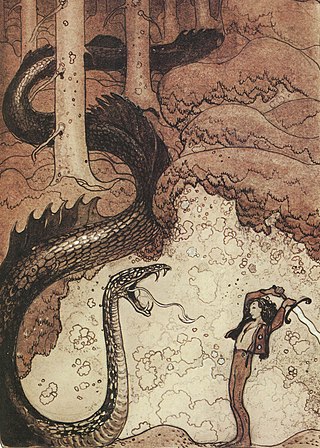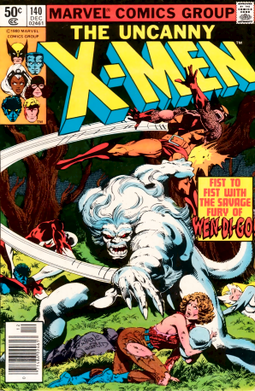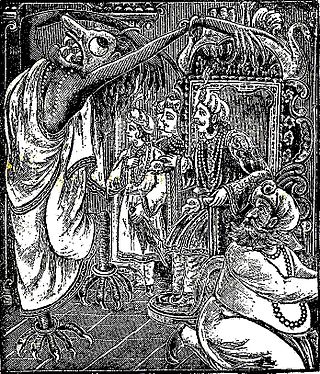Related Research Articles

In folklore, a werewolf, or occasionally lycanthrope is an individual who can shape-shift into a wolf, either purposely or after being placed under a curse or affliction, with the transformations occurring on the night of a full moon. Early sources for belief in this ability or affliction, called lycanthropy, are Petronius (27–66) and Gervase of Tilbury (1150–1228).

Efik mythology consists of a collection of myths narrated, sung or written down by the Efik people and passed down from generation to generation. Sources of Efik mythology include bardic poetry, art, songs, oral tradition and proverbs. Stories concerning Efik myths include creation myths, supernatural beings, mythical creatures, and warriors. Efik myths were initially told by Efik people and narrated under the moonlight. Myths, legends and historical stories are known in Efik as Mbụk while moonlight plays in Efik are known as Mbre Ọffiọñ.

In Japanese folklore, kitsune are foxes that possess paranormal abilities that increase as they get older and wiser. According to yōkai folklore, all foxes have the ability to shapeshift into human form. While some folktales speak of kitsune employing this ability to trick others—as foxes in folklore often do—other stories portray them as faithful guardians, friends, and lovers.

A pixie is a mythical creature of British folklore. Pixies are speculated to be particularly concentrated in the high moorland areas around Devon and Cornwall, suggesting some Celtic origin for the belief and name.

The lindworm, also spelled lindwyrm or lindwurm, is a mythical creature in Northern and Central European folklore living deep in the forest that traditionally has the shape of a giant serpent monster. It can be seen as a sort of dragon.
Wendigo is a mythological creature or evil spirit originating from the folklore of Plains and Great Lakes Natives as well as some First Nations. It is based in and around the East Coast forests of Canada, the Great Plains region of the United States, and the Great Lakes region of the United States and Canada, grouped in modern ethnology as speakers of Algonquian-family languages. The wendigo is often said to be a malevolent spirit, sometimes depicted as a creature with human-like characteristics, which possesses human beings. The wendigo is said to invoke feelings of insatiable greed/hunger, the desire to cannibalize other humans, and the propensity to commit murder in those that fall under its influence.
The warforged are one of the playable fictional races of creatures in the Eberron campaign setting of the Dungeons & Dragons fantasy role-playing game.

The xana is a character found in Asturian mythology. Always female, she is a creature of extraordinary beauty believed to live in fountains, rivers, waterfalls or forested regions with pure water. The origin of the Asturian word xana is unclear, though some scholars see it as a derivation from the Latin name for the goddess Diana. References to where the mythological xanas lived are still common in Asturian toponyms. They also appear in Eastern Galician and Cantabrian mythology (Anjanas).

The Wendigo is a fictional monster appearing in American comic books published by Marvel Comics. The Marvel character is based on the Wendigo legend of the Algonquian peoples. The monster first appeared in The Incredible Hulk #162, created by writer Steve Englehart and artist Herb Trimpe, fighting the Incredible Hulk.

Mermaid Saga is a Japanese manga series written and illustrated by Rumiko Takahashi. It consists of nine stories told in 16 chapters irregularly published in Shogakukan's Shōnen Sunday Zōkan and Weekly Shōnen Sunday from 1984 to 1994.
In the Anita Blake: Vampire Hunter series of novels, author Laurell K. Hamilton has developed a detailed mythology. Her series is an alternate history in which the supernatural is real, and vampires, lycanthropes, and other supernatural beings live alongside humans in a society that otherwise resembles 21st century North America.

The Patasola or "one leg" is one of many legends in South American folklore about female monsters from the jungle, appearing to male hunters or loggers in the middle of the wilderness when they think about women. The Patasola appears in the form of a beautiful and seductive woman, often in the likeness of a loved one, who lures a man away from his companions deep into the jungle. There, the Patasola reveals her true, hideous appearance as a one-legged creature with ferocious vampire-like lust for human flesh and blood, attacking and devouring the flesh or sucking the blood of her victims.

An ala or hala is a female mythological creature recorded in the folklore of Bulgarians, Macedonians, and Serbs. Ale are considered demons of bad weather whose main purpose is to lead hail-producing thunderclouds in the direction of fields, vineyards, or orchards to destroy the crops, or loot and take them away. Extremely voracious, ale particularly like to eat children, though their gluttony is not limited to Earth. It is believed they sometimes try devouring the Sun or the Moon, causing eclipses, and that it would mean the end of the world should they succeed. When people encounter an ala, their mental or physical health, or even life, are in peril; however, her favor can be gained by approaching her with respect and trust. Being in a good relationship with an ala is very beneficial, because she makes her favorites rich and saves their lives in times of trouble.

Colombian folklore are beliefs, customs and cultural traditions in Colombia.

Legends of vampires have existed for millennia; cultures such as the Mesopotamians, Hebrews, ancient Greeks, and Romans had tales of demonic entities and blood-drinking spirits which are considered precursors to modern vampires. Despite the occurrence of vampire-like creatures in these ancient civilizations, the folklore for the entity known today as the vampire originates almost exclusively from early 18th-century Southeastern Europe, particularly Transylvania, Hungaria as verbal traditions of many ethnic groups of the region were recorded and published. In most cases, vampires are revenants of evil beings, suicide victims, or witches, but can also be created by a malevolent spirit possessing a corpse or a living person being bitten by a vampire themselves. Belief in such legends became so rife that in some areas it caused mass hysteria and even public executions of people believed to be vampires.

The Berbalangs are mythical creatures in Filipino culture, described as ghouls who eat human flesh. They feed by digging up corpses from graveyards or by hunting living humans using flight and other supernatural powers. They are associated with the culture of the smaller towns of Mindanao. The lore on Berbalangs has similarities with that on Aswang creatures.

Ghosts are an important and integral part of the folklore of the socio-cultural fabric of the geographical and ethno-linguistic region of Bengal which presently consists of Bangladesh and the Indian states of West Bengal and Tripura. Fairy tales, both old and new, often use the concept of ghosts. References to ghosts are often found in modern-day Bengali literature, cinema, radio and television media. There are also alleged haunted sites in the region. The common word for ghosts in Bengali is bhoot or bhut. This word has an alternative meaning: 'past' in Bengali. Also, the word Pret is used in Bengali to mean ghost. In Bengal, ghosts are believed to be the unsatisfied spirits of human beings who cannot find peace after death or the souls of people who died in unnatural or abnormal circumstances like murders, suicides or accidents. Non-human animals can also turn into ghosts after their death. But they are often associated with good luck and wealth in Bangladesh.

West African mythology is the body of myths of the people of West Africa. It consists of tales of various deities, beings, legendary creatures, heroes and folktales from various ethnic groups. Some of these myths traveled across the Atlantic during the period of the Trans-Atlantic slave trade to become part of Caribbean, Cuban and Brazilian mythology.
Bethany C. Morrow is an American author. She writes speculative fiction for adult and young adult audiences and is the author of Mem (2018), A Song Below Water (2020), So Many Beginnings: A Little Women Remix (2021), and the editor of YA anthology Take the Mic (2019).
In the Philippines, a handful of superstitious beliefs exist that are very famous amongst the natives. These beliefs are typically introduced to them at a very early age through children's books or bedtime stories. It is believed that if natives aren't careful to follow them, a curse will befall them.
References
- 1 2 3 4 Knappert, Jan (1995). African Mythology: An Encyclopedia of Myth and Legend. Diamond Books. pp. 83–34. ISBN 978-0-261-66653-5.
- ↑ Henry, Veronica (2021). Bacchanal. 47North. ISBN 978-1-5420-2775-5.
- ↑ Morrow, Bethany (June 1, 2021). A Chorus Rises: A Song Below Water (Hardcover ed.). Tor Teen. ISBN 978-1250316035.